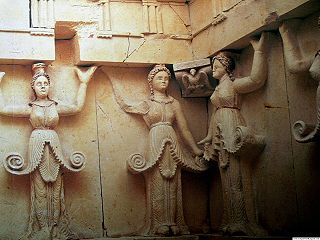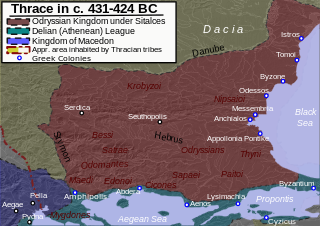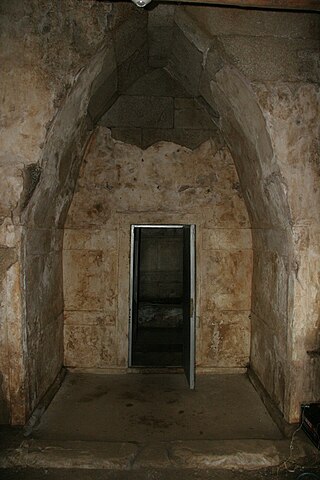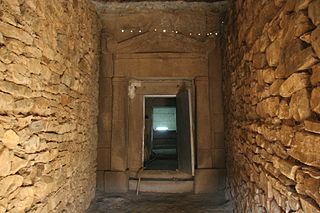
Kazanlak, known as Seuthopolis in ancient times, is a town in Stara Zagora Province, Bulgaria. It is located in the middle of the plain of the same name, at the foot of the Balkan mountain range, at the eastern end of the Rose Valley. It is the administrative centre of the homonymous Kazanlak Municipality.

The Thracian Tomb of Svestari is 2.5 kilometers (1.6 mi) southwest of the village of Sveshtari, Razgrad Province, which is 42 kilometers (26 mi) northeast of Razgrad, in northeast Bulgaria. The tomb is probably the grave of Dromichaetes who was a king of the Getae on both sides of the lower Danube around 300 BCE, and his wife, the daughter of King Lysimachus who was a general and diadochus of Alexander the Great. The tomb is a UNESCO World Heritage Site.

The Odrysian kingdom was an ancient Thracian state that thrived between the early 5th century BC and the early 3rd / late 1st century BC. Located in present-day Bulgaria, southeastern Romania, northern Greece and European Turkey, it was a tribal amalgam dominated by the Odrysians that was the first large political entity to develop in the eastern Balkans.

The Thracian Tomb of Kazanlak is a vaulted-brickwork "beehive" (tholos) tomb that is located near the town of Kazanlak in central Bulgaria.

Georgi Kitov was a Bulgarian archaeologist and thracologist. He specialized in Thracian archaeology. He participated in the excavations of many sites including the Alexandrovo Tomb, Kosmatka, Svetitzata and Starosel Cult Complex.

Seuthopolis was an ancient hellenistic-type city founded by the Thracian king Seuthes III between 325–315 BC which was the capital of the Odrysian kingdom.

The Thracians were a group of Indo-European tribes inhabiting a large area in Central and Southeastern Europe, centred in modern Bulgaria. They were bordered by the Scythians to the north, the Celts and the Illyrians to the west, the Greeks to the south, and the Black Sea to the east.

Seuthes III was a king of Odrysia, a part of Thrace, during the late 4th century BC.
Raizdos was possibly a king of the Odrysians in Thrace in the early 3rd century BC. He is attested in an inscription from Delphi as the father of Kotys III, who was king sometime between 276 and 267 BC. The date and the names suggest the possibility that Raizdos was the son of Kotys II, himself attested in an inscription from Athens dated to 330 BC. Several scholars have considered the name "Raizdos" a variant orthography of "Roigos", a Thracian royal name found on 3rd-century BC coins and in a graffito in the Kazanlăk Tomb, naming "Roigos, son of Seuthes." Even if the two names are variant forms of the same name, it remains uncertain whether Kotys III's father Raizdos can be identified with Roigos, son of Seuthes. No Raizdos is attested among the several known sons of Seuthes III.
Roigos was an Odrysian king in Thrace during the 3rd century BC. He is known primarily from his rare coinage and a graffito inscription from the Kazanlăk Tomb revealed in 2008 by Konstantin Bošnakov. Roigos' obscurity contrasts with the apparently secure attribution of the opulent Kazanlăk Tomb to him, and his precise chronological position and relationships remain unclear. According to the graffito inscription, Roigos was the son of a Seuthes, but which of the kings named Seuthes is meant is uncertain. Given the tomb's location near Seuthopolis and the widespread tendency to associate most spectacular finds in the area with the town's famous founder Seuthes III, Roigos has been declared a son of Seuthes III by some authors, and Gonimase (Gonimasē), wife of a Seuthes, has been proposed as Roigos' mother. Others have pointed out the possibility that the name "Roigos" is a variant orthography of "Raizdos" and have suggested identifying him with Raizdos, the father of Cotys III. While both identifications could be correct, even if the two names are variants of the same name, they could apply to different individuals. Much of this depends on the uncertain chronology of Roigos. Bošnakov dated the Kazanlăk Tomb to the mid-3rd century BC, which would preclude identifying Roigos' father Seuthes with Seuthes III. This would be compatible with a mid-3rd century date for the destruction of Seuthopolis, which has been proposed as a correction to the more traditional association of the town's end with the Celtic incursions of the 270s BC. Depending on whether he belongs in the middle or the beginning of the 3rd century BC, Roigos has been tentatively placed as either a great-grandson or as a (unattested) son of Seuthes III: Seuthes III - Teres IV - Seuthes IV - Roigos or Seuthes III - Roigos. If the second conjectural pedigree is correct, Roigos could be identified with Raizdos, whose father is unknown, and whose son Cotys III is attested as king sometime between 276 and 267 BC.
Seuthes IV was a possible king of the Odrysians in Thrace during the 3rd century BC. Seuthes IV is an obscure figure, and the little that is known depends on inference from very limited information that may apply to him or others of the same name. Roigos, son of Seuthes, buried in the Kazanlăk Tomb, may be identified as the son of Seuthes IV, if Roigos and his tomb date to the mid-3rd century BC ; if, on the other hand, Roigos belongs in the early 3rd century BC, he could be identified as an otherwise unattested son of Seuthes III instead. In 2007, the Bulgarian archaeologist Georgi Kitov and his team excavated a Thracian burial mound known as Dalakova Mogila near the village of Topolčane near Sliven. The burial was of a royal or aristocratic warrior, buried in relative hurry with military equipment including an arrow-pierced silver helmet, a golden pectoral, various other vessels, many of them of gold, and a gold ring bearing the inscription that was eventually determined to read "Seuthes son of Teres" alongside a depiction of the owner as a bearded mature man with a possibly receding hairline. The date of the burial is uncertain. If it belongs to the 5th century BC, the Seuthes in question could be a son of the obscure Teres II, who was a contemporary of Seuthes II's father Maesades. A 4th-century BC date could make the Seuthes of the ring a son of Teres III, but he appears to be distinct from the famous Seuthes III who appears to have been buried elsewhere. An early 3rd-century BC date could make this Seuthes the son of Seuthes III's son Teres.

The Aleksandrovo tomb is a Thracian burial mound and tomb excavated near Aleksandrovo, Haskovo Province, South-Eastern Bulgaria, dated to c. 4th century BCE.

The Ostrusha mound is a Thracian burial tumulus near the Bulgarian town of Shipka. It was constructed in the middle of the 4th century BCE. The stone structures under the more than 18 meters high mound form one of the biggest representative tomb-cult complexes with 6 rooms on an area of 100 square meters. It was professionally excavated in 1993.

The Thracian tomb at Shushmanets is a mound located in the Valley of the Thracian Rulers. It was built as a temple in the 4th century BC and later used as a tomb.

The Thracian tomb "Helvetia" mound near Shipka, Bulgaria, was built in the middle of the 4th century BC.

Golyama Arsenalka mound is a Thracian burial tumulus with a subterranean stone building near the Bulgarian town of Shipka. It dates from the end of 5th century BCE.

The Thracian tomb Griffins, found in Bulgaria, has a façade decorated with plastic columns and with a pediment above them. The pediment`s ends are semi-palmettes, the lower leaves of which are elongated and look like heads of griffins. The temple was built in the 5th century BC. There is a corridor made from river stones, floored with earth. The façade, the antechamber and the circular chamber are built of granite blocks. The entrances to the antechamber and the dome chamber had been closed by stone doors which were found broken during the research of the facility. The antechamber is of rectangular shape and has a double-pitched roof. The round chamber is covered with fine-made dome. The floors of both rooms are made of plastered granite slabs. Opposite the entrance of the circular chamber is situated a ritual stone bed with decorations. On a stone block in front of the bed were found gold paws. A funeral took place in the temple in the 4th century BC. The corridor was filled with river stones and soil. It was robbed in antiquity.

The Valley of the Thracian Rulers is a name which was made popular by the archaeologist Georgi Kitov and describes the extremely high concentration and variety of monuments of the Thracian culture in the Kazanlak Valley in Bulgaria. It is believed that there are over 1500 tumuli in the region, with only 300 being researched so far.

The gold wreaths from Thrace are jewellery wreaths found in inner Thrace, which is within present day Bulgaria. The gold wreaths were found in the mounds and tombs of aristocrats at various locations in Thrace that have been dated to a period from the latter half of the fourth century and early part third century BC.

The Mogilan mound or Mogilanska mound is a burial mound in the center of Vratsa, Bulgaria.





















